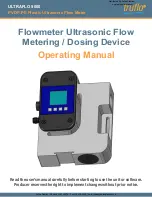
SECTION 4
MAINTENANCE
4.1
GENERAL
The Model 3345 is designed to give optimum performance with minimum maintenance. It is only
necessary to keep the external surfaces clean and free from dust. To give added protection when the unit
is not in use the unit should be disconnected from the mains supply and covered with the optional dust
cover (544 008). For longer term storage or re-shipment it is recommended that the unit be returned to the
original packing case.
4.2 CLEANING/RE-CONDITIONING OF GLASS ELECTRODES
For general purpose use combination electrodes can be cleaned with a mild detergent solution or a commer-
cial glass cleaning solution (provided these are not strongly acidic). The electrode surface should be wiped
with a clean cloth soaked in the cleaning agent, and/or allow the membrane to stand in the solution until clean.
Rinse and repeat as necessary.
TABLE FOR CLEANING OF GLASS ELECTRODES
NOTE: Epoxy bodied electrodes should not be cleaned with aggressive solvents.
DEPOSIT
CLEANING AGENT
General deposits
Mild detergent solution
Inorganic coatings
Commercial glass cleaning solution (not strongly acidic)
Metal compounds
Acid solution, not stronger than 1M
Oil/Grease
Complexing agent (EDTA) or suitable solvent
Resins/Lignins
Acetone, alcohol or detergent (not strongly alkaline)
Proteins (blood, etc)
Enzyme solutions e.g. pepsin in 0.1M HCl
Stubborn deposits
Weak hydrogen peroxide solution, sodium hypochlorite solution
or domestic bleach
Electrodes which have been allowed to dry out (often indicated by a hard, dry deposit of KCl crystals on the
electrode body) should be rehabilitated by soaking overnight in warm distilled water.
4.3 ION SELECTIVE ELECTRODES
Refer to the Instruction Sheet supplied with the electrode.
SECTION 5
OPTIONAL ACCESSORIES
A wide range of optional accessories and electrodes are available for use with the Model 3345. Please
consult your local Distributor or manufacturer for a full list.
3345/REV A/08-99
39












































